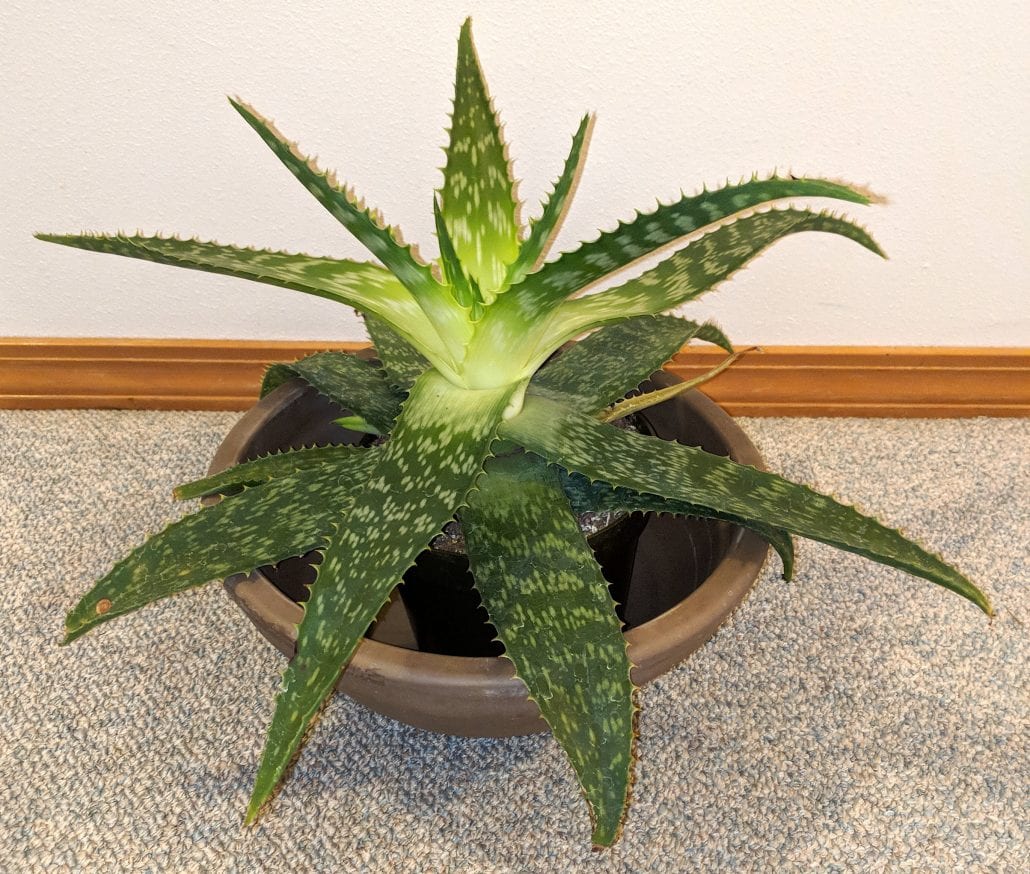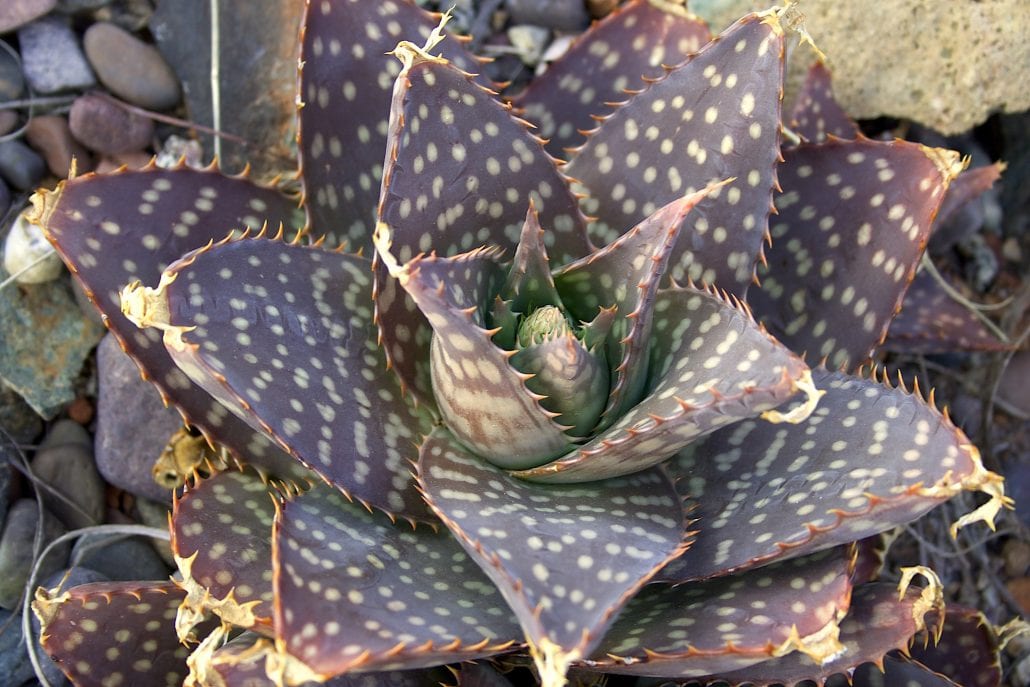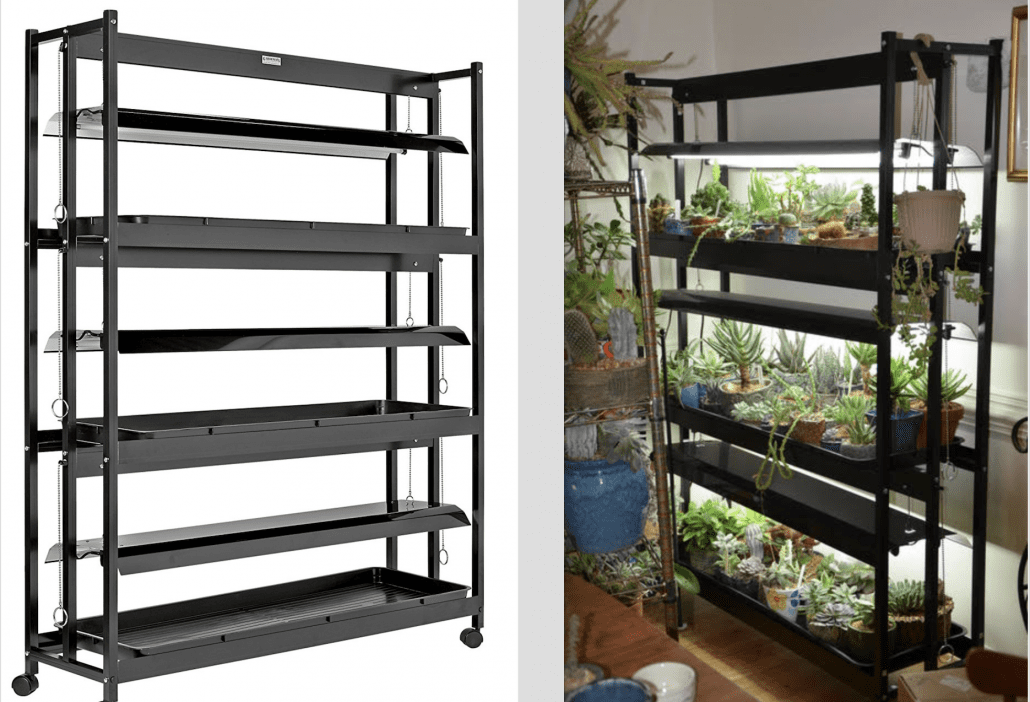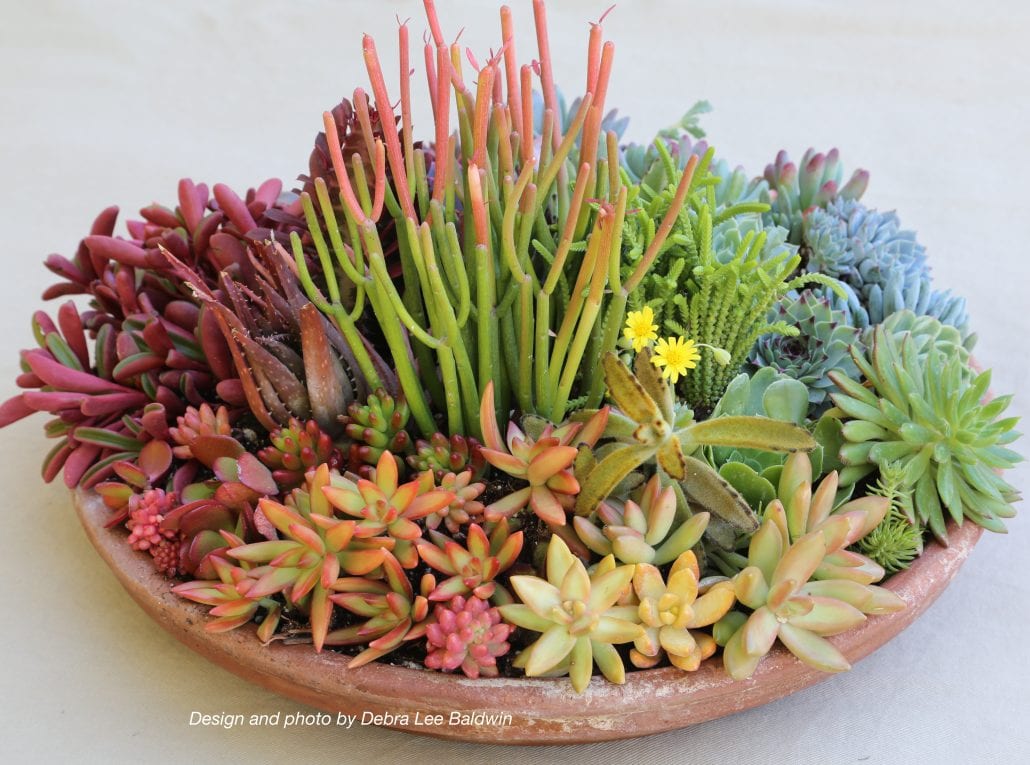
The things I do for you! This agave snout-nose weevil is on my palm, headed for my wrist and arm.
The agave snout-nose weevil is a half-inch-long black beetle with a downward-curving proboscis that enables it to pierce an agave’s core, where it lays its eggs. Grubs hatch, consume the agave’s heart, then burrow into the soil to pupate. The weevil (Scyphophorus acupunctatus)—once prevalent only in desert regions and Mexico—is spreading rapidly throughout the US and abroad, earning it the dubious distinction of being one of the “Top 100 Worst Global Invasive Species.”

A block from my home, the middle agave shows signs of snout weevil infestation.
According to the Global Invasive Species Database, “Scyphophorus acupunctatus is becoming a major pest of native Agavaceae and Dracaenaceae species worldwide. Native to Mexico, it has decimated populations of Agave crops there, in particular species used in the tequila industry. The importation of ornamental Agave plants worldwide has facilitated S. acupunctatus to establish in many parts of the world, particularly in Central America and the Caribbean, in Africa, Asia and South America.”

Is your agave infested? Look for damaged tissue where leaves meet stem. The lowest leaves will appear wilted, and may slope unnaturally downward while the center cone remains upright. The plant, no longer anchored by roots, will rock when pushed. When an infestation is well underway, it’s possible to shove the agave over onto its side. It’ll break at soil level, revealing a mushy, foul-smelling core infested by plump, squirming, half-inch, cream-colored grubs with brown heads.

Above: an agave’s grub-eaten core resembles a sponge.

Above: Close-up of a snout-nose grub.
In my YouTube video, “Agave Snout Weevil Prevention and Treatment,” I demonstrate how to inspect nursery agaves, show resistant varieties, and interview agave expert Kelly Griffin at an infested colony of Agave americana. Kelly also talks about applying a systemic insecticide as a prophylactic (preventive) option.
How one homeowner does it: Succulent collector Jeanne Meadow is well versed in both the fauna and flora of her large garden in Fallbrook, California, midway between Riverside and San Diego. Jeanne, an ace researcher, has become an expert on the agave snout-nose weevil. She says people tend to assume most nursery plants are pest-free, yet that’s the primary way snout weevil enters gardens. When an agave in her garden shows signs of infestation, she removes it and every plant for several feet surrounding it. Then she sifts the soil and picks out grubs and beetles. “It’s a huge undertaking,” Jeanne says. “Fortunately they’re slow crawlers.”
What about insecticides? Although neither Jeanne nor I advocate commercial insecticides, we agree that the responsible thing to do is to prevent the beetle from spreading. “This is an emergency situation,” Jeanne says. “The pest is spreading like crazy and has to be brought under control.” She drenches the soil around her agaves with an insecticide that has imidacloprid as the main ingredient. One brand is Compare-N-Save Systemic Tree and Shrub Insect Drench. It contains 1.47% imidacloprid and costs about $52/gallon on Amazon.

Another brand is Bayer Tree and Shrub Insect Control with 2.94% imidacloprid. About $90/gallon on Amazon.

How to treat your agaves. The goal is to get the mix to the agave’s roots without wasting it on leaves or splashing nearby plants.
Twice a year, in spring and fall:
1. The night before, soak (hose-water) the soil at the base of each agave to aid penetration.
2. To mix the solution, you’ll need a hose, a 3-to-5 gallon bucket and a stick for stirring. Product labels don’t say how much imidacloprid concentrate per gallon of water for agaves, so go with the ratio for shrubs. (If using Compare-N-Save, it’s 3 oz. per foot of height per gallon of water.)
3. Agaves naturally funnel rainwater water to their roots, so if you slosh the solution where lowest leaves meet the core, you’ll effectively drench the soil right below them, around the base of the plant.
Note: Avoid doing this in temperatures above 80 degrees F. High temps diminish the insecticide’s effectiveness and may even harm plants already stressed by heat. Although some studies claim that imidacloprid is safe for bees, err on the side of caution and treat only the soil immediately around the agave where no other plants grow. Also remove any agave bloom spikes before buds become flowers. (See Green Alert below.)
Be sure to pass the word. It’s only a matter of time before weevils in neighbors’ agaves find their way to yours and vice-versa. The unfortunate reality is that agave owners who do nothing are inadvertently aiding the proliferation of a serious pest, and will likely incur the expense and inconvenience of removing spiky, hefty plants.
— Send close neighbors a friendly email with a link to this page.
— Post about agave snout weevil on your neighborhood’s online forum (include a photo of an infested agave in your area, if available).
— Copy-and-paste this in an email to the editor of your community newsletter. (Normally you’d need my permission, but in this case, all I ask is to be credited.)
Don’t assume your agaves won’t be affected. Although snout-nose weevils can’t fly (yes, there are such things as flightless beetles), they sure can walk. I first suspected that snout-nose had arrived in my backcountry community northeast of San Diego when I noticed a collapsed Agave americana in a friend’s garden. I could barely believe it. She lives atop a rocky hill surrounded by acres and acres of native chaparral. Either the weevil had arrived via infested nursery stock (on a different agave most likely, seeing as the sick plant was part of an old colony), or it had walked in. I’ve observed that it takes a captive weevil ten days to die despite receiving no water nor food. The entire time, “mine” was mobile and easily could have walked several blocks—doubtless, much farther. It also was a surprisingly good climber.
Consider: If a dying agave hosts dozens of grubs that turn into beetles, and if each takes off in a different direction, one or more will certainly find another agave.
Green alert: Insecticides kill beneficial insects as well as pests and may disrupt your garden’s natural predator-prey balance. Snout weevils have coexisted with agaves for millennia and are naturally preyed upon by reptiles, birds and mammals (though the spines that protect an agave from predation also protect the weevil). Systemics, as the name implies, transmit insecticide through a plant’s system, so any bug that ingests it dies. Animals farther up the food chain may not be at risk, but imidicloprid can get into groundwater. I do like the idea of my garden’s lizards feasting on the grubs, which look like meal worms sold in pet stores. Yet much more, I want to preserve my garden’s largest, most venerable and valuable succulents while simultaneously doing my part to slow the beetle’s encroachment into my neighbor’s gardens and beyond.
Sad news. Treatment may not prevent an agave from being weakened, because the weevil is a vector (carrier) of Erwinia carotovora, a micro-organism that softens the tissues, enabling its grubs to easily consume it. After chewing into an agave that has been treated with a systemic, a beetle will likely die, but the insecticide won’t kill the bacteria that the bug introduced. If your goal is to kill snout weevils before they spread, a systemic ought to do it. But if the pest is in your area, there’s no guarantee your plants won’t be affected. As to what degree, I don’t know yet. (Check back.)
Good news. An organic control currently under development is a pheromone trap designed to attract adult beetles in search of mates. Weevil-resistant Agave varieties are being selected and bred; however, it may be years before a good supply is available. (Again, check back with me. I’ll update this page as info becomes available.)
Weevil control without pesticides. Remove an agave at first sign of infestation and sift grubs and weevils out of the soil. (Feed them to your chickens or put them out with the trash in sealed plastic bags.) Don’t plant agaves in that part of your garden again, and watch your other agaves for signs of infestation. It’s possible that beneficial nematodes may be effective. They do kill larvae, but I’ve yet to learn their effectiveness against snout weevil. (Check back.)

In the meantime…
Plant agaves bare-root. Before planting, remove an agave from its nursery pot, set the plant (root ball and all) in a wheelbarrow, and hose the soil off the roots. Examine the plant for beetles and puncture holes, and the soil for grubs. If a plant is infested, destroy it and inform the source nursery. Jeanne notes that when chased, weevils head back to the agave for shelter. “They don’t try to escape from the wheelbarrow.” Btw, after observing grubs kept alive in soil-filled jars, Jeanne says that when deprived of an agave to feed on, grubs don’t pupate (turn into weevils).
Grow agaves in pots. In areas where snout weevil is known to be active, plant agaves in containers like the urns shown here. You’ll know that the soil is OK because it came from a bag; you can easily get rid of infested soil should beetles show up; and when you apply a preventative drench, only the soil in the container is affected. Additional advantages are that pots elevate agaves for better viewing, enabling them to serve as garden focal points even when small. Potentially immense, pupping agaves (such as A. americana species) grow more slowly in containers, which also serve to corral their offsets.
So, which agaves are susceptible? Resistant? Snout weevil seems to prefer Agave americana (especially mature ones and variegates), but will go after other Agave species. It seems less inclined toward agaves with thin, flexible leaves, such as Agave attenuata; those with tough, hard-to-pierce leaves (such as agaves ‘Sharkskin’, triangularis, and victoriae-reginae); and those with slender, nonjuicy leaves such as A. bracteosa and A. filifera. Reportedly, it infests other genera in the Agavaceae family, such as Nolina, Beaucarnea, Yucca, and Furcraea. I’ve heard, but have yet to confirm, that it also attacks Mexican fence post cactus (Pachycereus marginatus) and possibly barrel cacti — but symptoms may simply be due to a different bug. After all, any post-Eden garden is a Pandora’s box.
Finally, don’t give up on agaves! “Snout-nose shouldn’t discourage anyone from planting agaves,” Jeanne says. “There IS hope, and my garden is a great example of that.” She adds that the imidacloprid drench—which degrades over time—has had no negative impact on her garden’s overall health and ecosystem, “including its population of beneficial insects, reptiles, birds, and amphibians.”
More info:
UC Nursery and Floracultural Alliance Regional Report, Spring 2016, “Agave Pests”
Global Invasive Species Database
Desert Botanical Garden, Phoenix, AZ
Pam Penick’s blog post: “Evil Weevils! Agaves Under Attack in Austin”
Tropical Texana blog: http://ift.tt/2EK8Jzk
View my 7-minute YouTube video, Agave Snout Weevil Prevention and Treatment
Note: This post first appeared in August, 2016. I’ve updated it several times, most recently in Jan., 2018. — Debra
The post Agave Snout Weevil Prevention and Treatment appeared first on Succulents and Succulent Garden Design | Debra Lee Baldwin.
from Succulents and Succulent Garden Design | Debra Lee Baldwin http://ift.tt/2FFEk6j
via
IFTTT











